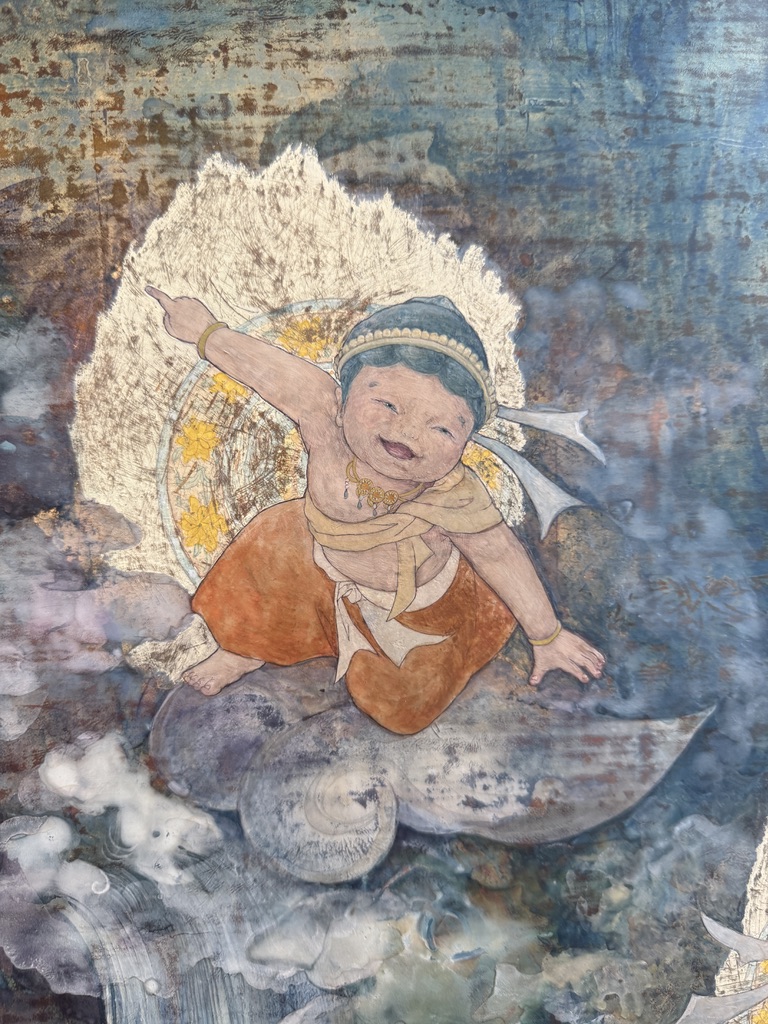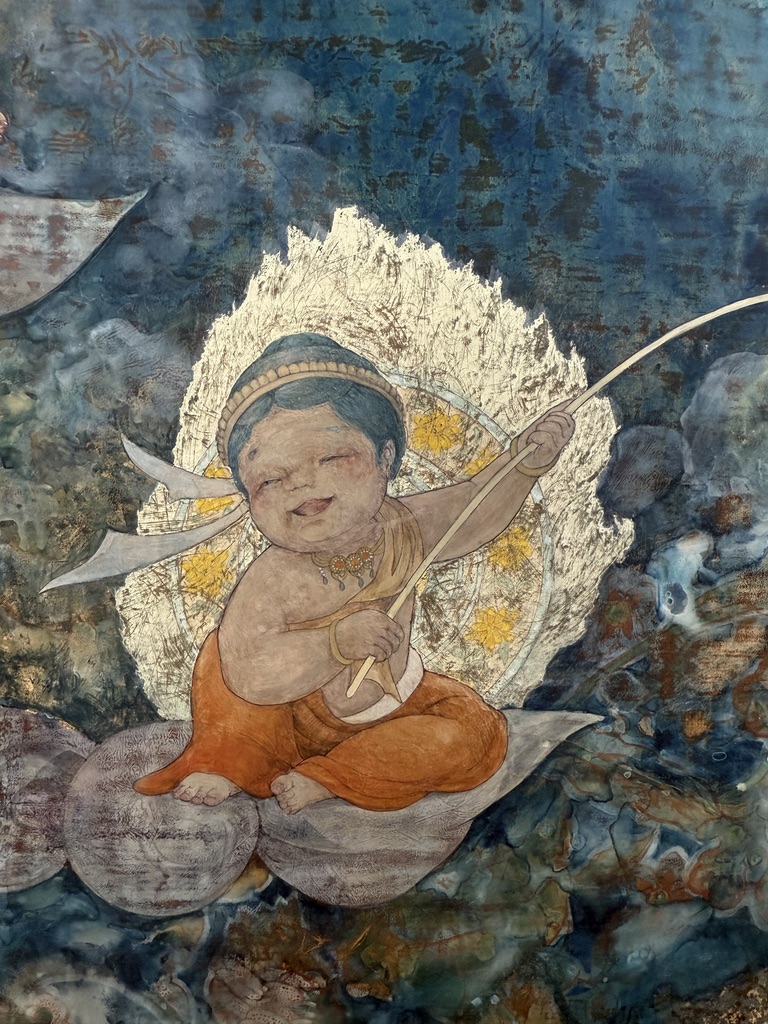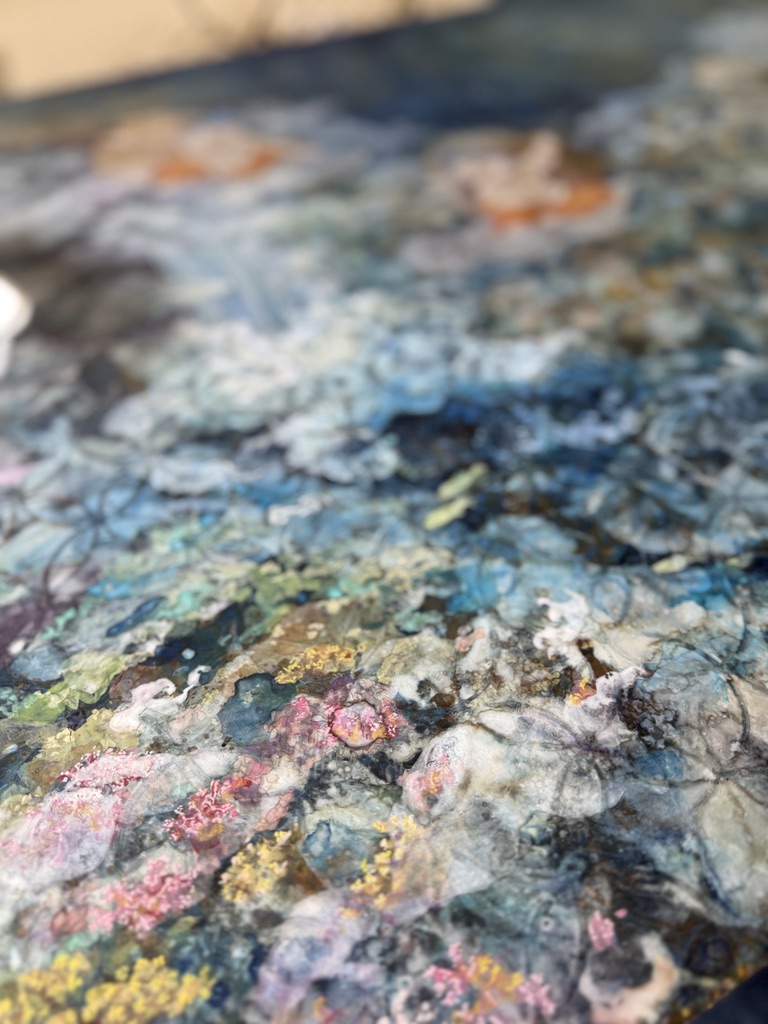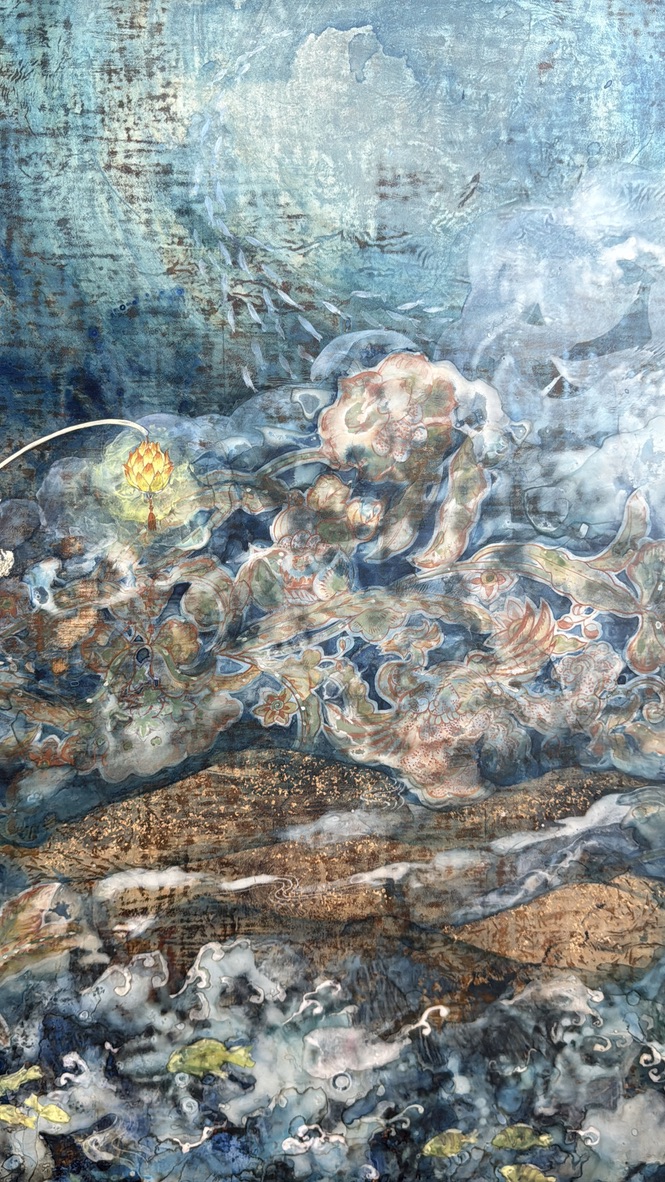Painting
Echoes of Pratītyasamutpāda
Story
Living deep in the mountains, I’ve often found myself confronted by the overwhelming power of nature—and the helplessness of being human.
There were nights when storms shook the forest, the mountains howled with wind, and the river roared in the dark.
With the electricity out and the house plunged into pitch black, I clutched my small daughter’s hand tightly beneath the blankets, ready to face whatever might come, just wanting to be with her to the very end.
On another day, snow piled up to the eaves, sealing us indoors. The glass doors creaked under the weight, and we had no access to firewood, electricity, or gas.
I held my daughter close for warmth, sharing our food, waiting in silence for help to arrive.
In such moments, surrounded by animals braving the same storms, I felt deeply that humans are no different—we are just as fragile, just as much a part of nature.
And then, I remembered the Buddha’s words:
“Even as a mother protects with her life
her child, her only child,
so with a boundless heart
should one cherish all living beings.
Let one cultivate a boundless love towards the whole world.”
— Sutta Nipāta, Chapter 8
Just as I would risk everything to protect my daughter, so too should we extend that same compassion to all living beings.
Every single life—like hers—is irreplaceable, fragile, and precious.
And all life exists not in isolation, but only through interdependence—through the endless interactions and connections between all things.
When I began to see the world this way, the boundaries that once seemed so clear began to dissolve.
There is no true line between mountain and sky, between you and me, or even between my skin and the world outside.
These are illusions—boundaries that appear only when we choose to see them.
Instead, I began to feel the world as a vast, seamless flow:
Mountains and rivers, plants and animals, people and fish, words and emotions—all interwoven, all connected, all in motion.
While gazing at the vast natural world outside and holding this vision within, another verse from the Buddha surfaced in my mind:
“May all beings—whether weak or strong,
large or small,
visible or invisible,
near or far,
born or yet to be born—
may all beings be happy.
Let none deceive or despise another anywhere.
Let none through anger or ill will wish harm upon another.”
— Sutta Nipāta, Chapter 8
When read with the understanding that everything is interconnected, this passage offers a glimpse of how the Buddha might have perceived the world—a web of boundless compassion.
Though all living beings are driven by desires, struggling to protect the life they were born into,
each of these lives is not separate, but part of a greater whole.
Together, they form one vast, breathing organism we call Earth.
Perhaps this is the truth the Buddha saw.
Perhaps this is Nirvāṇa—a world without boundaries, where all life flows as one.
This piece, Issui-Issai (One Water, All Things), was created to express this vision.
Here, water symbolizes the great cycle of life—flowing, connecting, sustaining.
The heavenly beings, the hiten, appear when a Buddha manifests, scattering flowers and playing celestial music.
When I first saw the hiten carved into the walls of the Byōdō-in Temple, their joyful expressions struck me with a sense of innocence and wonder.
Though invisible to us, perhaps they are always here—blessing and embracing every living thing.
In this work, I wanted to create a world without clear boundaries—a place where everything merges and resonates like waves.
This is my first step toward glimpsing the world the Buddha might have seen.
There were nights when storms shook the forest, the mountains howled with wind, and the river roared in the dark.
With the electricity out and the house plunged into pitch black, I clutched my small daughter’s hand tightly beneath the blankets, ready to face whatever might come, just wanting to be with her to the very end.
On another day, snow piled up to the eaves, sealing us indoors. The glass doors creaked under the weight, and we had no access to firewood, electricity, or gas.
I held my daughter close for warmth, sharing our food, waiting in silence for help to arrive.
In such moments, surrounded by animals braving the same storms, I felt deeply that humans are no different—we are just as fragile, just as much a part of nature.
And then, I remembered the Buddha’s words:
“Even as a mother protects with her life
her child, her only child,
so with a boundless heart
should one cherish all living beings.
Let one cultivate a boundless love towards the whole world.”
— Sutta Nipāta, Chapter 8
Just as I would risk everything to protect my daughter, so too should we extend that same compassion to all living beings.
Every single life—like hers—is irreplaceable, fragile, and precious.
And all life exists not in isolation, but only through interdependence—through the endless interactions and connections between all things.
When I began to see the world this way, the boundaries that once seemed so clear began to dissolve.
There is no true line between mountain and sky, between you and me, or even between my skin and the world outside.
These are illusions—boundaries that appear only when we choose to see them.
Instead, I began to feel the world as a vast, seamless flow:
Mountains and rivers, plants and animals, people and fish, words and emotions—all interwoven, all connected, all in motion.
While gazing at the vast natural world outside and holding this vision within, another verse from the Buddha surfaced in my mind:
“May all beings—whether weak or strong,
large or small,
visible or invisible,
near or far,
born or yet to be born—
may all beings be happy.
Let none deceive or despise another anywhere.
Let none through anger or ill will wish harm upon another.”
— Sutta Nipāta, Chapter 8
When read with the understanding that everything is interconnected, this passage offers a glimpse of how the Buddha might have perceived the world—a web of boundless compassion.
Though all living beings are driven by desires, struggling to protect the life they were born into,
each of these lives is not separate, but part of a greater whole.
Together, they form one vast, breathing organism we call Earth.
Perhaps this is the truth the Buddha saw.
Perhaps this is Nirvāṇa—a world without boundaries, where all life flows as one.
This piece, Issui-Issai (One Water, All Things), was created to express this vision.
Here, water symbolizes the great cycle of life—flowing, connecting, sustaining.
The heavenly beings, the hiten, appear when a Buddha manifests, scattering flowers and playing celestial music.
When I first saw the hiten carved into the walls of the Byōdō-in Temple, their joyful expressions struck me with a sense of innocence and wonder.
Though invisible to us, perhaps they are always here—blessing and embracing every living thing.
In this work, I wanted to create a world without clear boundaries—a place where everything merges and resonates like waves.
This is my first step toward glimpsing the world the Buddha might have seen.
Summary
Echoes of Pratītyasamutpāda
Production year:2025
Media: Wood panel, soil, linen, Japanese tube paint, acrylic emulsion, gold leaf, water gold leaf, brass foil Tamamushi leaf
Size: F40
Please contact us by Email.
Please feel free to contact us for more information about our activities and works.








